- Anthony DeLeonardis
- Sep 30, 2023
- 9 min read
Experience what life was like before China opened its martial arts doors to the world.
China has always been the traditional home of the Asian martial arts. For 2,000 years, its people have experimented with and developed self-defense systems that have only recently become known in other countries as karate, judo, jujitsu and sumo.
Yet curiously, little is known of the Chinese martial arts (wushu) outside of China. The country has always been a mystery to the non-Chinese, and so it is today with the martial arts. And the Chinese have done little to make knowledge of its self-defense systems available to people abroad.

It’s remained for two other Asian nations, Japan and Korea, to popularize the Oriental fighting systems. They’ve been the driving force behind the worldwide boom in karate, yet both are relative newcomers to it. The “art of empty hands” was introduced to Japan only in 1917, and it didn’t get established in Korea until after World War II.
Furthermore, neither Japan nor Korea learned karate directly from Chinese sources. They got it from Okinawa, where the great Chinese-boxing styles had been introduced 400 years earlier. However, by the time the 20th century rolled around, the Okinawans had so altered the basic Chinese style that their version bore only a distant resemblance to the graceful movements of kung fu.
To the public, karate is still thought of as a native of Japan and Korea, but those who know the arts are paying more and more attention to the older Chinese systems. To keep readers abreast of what’s happening in the Chinese martial arts, Black Belt sent a correspondent to China to report on developments there. That trip has led to this special report, which will serve as an introduction to the subject. For it, we’ve selected six systems that illustrate the variety of the Chinese arts.
Tai Chi Chuan for the Masses The future of all the arts appeared uncertain when the communists came to power in 1949. The new masters of China looked with disfavor on many of the old ways and traditions, and it was feared that the martial arts would become one more casualty of the new order.
But when the regime instituted a nationwide physical-fitness program that required people of all ages to exercise, an interesting thing happened: Chinese citizens by the millions began obediently trudging to parks for their required early morning exercises, accompanied by military music blaring over loudspeakers.
But the exercises that many engaged in weren’t the drills that might be associated with physical-fitness books. They were exercises associated with the great boxing art of tai chi chuan, or “grand ultimate fist.” The government may have launched a new China, but it seemed as if the citizens were still approaching it in traditional ways.
Whatever doubts the communist leadership may have had about the martial arts at first, the situation is different now. In recent years, they’ve rushed to embrace the martial arts with passion.

A book published in 1963, titled Sports Go Forward in China, gives a tip-off to the new prestige the martial arts are enjoying. “Wushu … is a traditional sport acquired and evolved by the Chinese people in productive labor, self-defense and physical training,” the book states in typical communist propaganda terms.
Pulling out all the stops, it continues: “The aim of wushu is to cultivate agility, adroitness, stamina and strength. Besides its curative value in treating certain chronic diseases, regular practice in wushu is beneficial to the central nervous, respiratory, circulatory and digestive systems, as well as to the joints and muscles.”
China’s Sophisticated Martial Arts Before examining the different arts, it helps to cover some background. To the untrained eye, the Chinese martial arts might appear different from the better-known Japanese and Korean versions. The first thing that one notices is the grace of the old Chinese styles. In this respect, the Chinese arts would have to be called more “sophisticated” than the others. They’ve developed out of the world’s oldest culture—one that’s produced a brilliant civilization.
The result is fighting arts that are polished, elegant and dancelike—which explains why so many of kung fu techniques have poetic titles. The masters who developed these styles centuries ago were far too refined to refer to anything as a plain old punch to the temple, for instance. They preferred to cloak the deadliness of such a kung fu technique in an extravagant expression like the “beat of a stork’s wing’’ or “dipping for pearls.”
In contrast, the Japanese and Korean versions of karate are far less elegant in appearance. And the reason is not hard to find. The karate of these two countries came from Okinawa, which was a cultural and economic backwater of Asia. Populated almost exclusively by peasants and fishermen, Okinawa couldn’t hope to match the civilization of China.
Therefore, it’s not surprising that much of the finery of Chinese kung fu was lost during the 400-year development of the art on Okinawa. What emerged in the 20th century was a stripped-down version of kung fu. It became a rugged, no-nonsense system of deadly self-defense.
The Okinawans infused it with an emphasis on sheer power. This is essentially the style of karate practiced in Japan and Korea today, and it’s far stiffer than the Chinese versions in that it tends to rely on directness rather than the deceptive and flowing movements of kung fu. While the karate man delivers his punches and kicks straight forward with little side-to-side maneuvering, the kung fu stylist is on the move, whirling and twisting swiftly, coming at his opponent from all directions with a barrage of techniques. Speed is considered as important as power.
Sparring and the Chinese Martial Arts The grace and beauty of the Chinese styles leave the impression that they’re fancy arts—that they look pretty but are really slap-and-dash systems with little power. This is vigorously disputed by practitioners, who contend that the grace merely hides the power underneath.
A more pertinent criticism is that the Chinese practice only forms and no free sparring. Yet all karate men practice forms, in which the aim is to gain perfection and control. The Chinese say they don’t engage in free sparring because it’s too dangerous, that a student might lose control and land a blow too hard, thus causing injury.
But perhaps in recognition of this, the Chinese have for centuries issued challenges for personal combat to test which man or system is best in a no-holds-barred free-for-all. Many villages throughout the nation staged such contests every year, and they could be bloody affairs that cost the lives of contestants. This is in contrast to the Japanese and Korean arts, in which it’s emphasized that the skills should never be used for sport or revenge.
And even today, such challenges are occasionally issued, and the issue is fought out on the rooftops of Hong Kong or in Chinatown districts of the United States. Whether these personal confrontations still take place in China isn’t known.
Monasteries played a big part in the development of the martial arts throughout Asia. It was the priests of the temples who had the leisure time and the learning to develop the fighting arts. One monastery in particular deserves note. Shaolin Temple was one of the great centers of the arts in old China, and one of the boxing arts developed there eventually found its way to Okinawa.
But wherever the arts developed, they grew in great profusion with many masters adding their own touches over the years. And they’re still developing. Pa kua, for instance, is a product of the 20th century. And newer styles will no doubt continue to crop up regardless of who’s running China. Shown on the next few pages are some of the greatest of the various arts and a few that are not so well-known.
Eagle Claw Kung Fu One of the most famous forms of kung fu is called, menacingly enough, the eagle claw. And menacing it should be, for this system adopts as one of its more potent offenses a series of clawlike rakes to the eyes and throat. It’s spectacular to see the practitioner execute the magnificent leaps and kicks that the Chinese martial arts are famous for.
The basic hand position is as follows: The wrist is arched, and the fingers are spread and tensed as if forming a claw. Exercises to strengthen the hands are important, and students improve their grip by attempting to grasp and hold a greased jar using only their nails and fingertips.
The founder of the system was supposedly a great general and patriot, Yueh Fei, who lived from 1103 to 1141. Originally, the style was based on striking and clawing, with some throws reminiscent of modern judo and some joint locks similar to those of jujitsu and aikido. Own this classis by Marshall Ho'o!
However, during the Ming dynasty, a monk named Lai Chuen combined eagle claw with his own system, called faan tzi. The result is known as the faan tzi eagle-claw style. In addition to empty-hand techniques, it also teaches the art of the spear.
Wing Chun Kung Fu Wing chun kung fu has one of the more exotic backgrounds of the Chinese arts, for it was founded by a woman, Yim Wing Chun, 400 years ago. She took her basic self-defense training from another woman, a famous Buddhist nun named Ng Mui of the Sil Lum (Shaolin) monastery.
Yim Wing Chun supposedly founded her art because she believed that the styles of the time placed too much emphasis on the “strong horse” techniques, relying on sheer strength. She came up with a system of body dynamics and techniques that she believed could apply energy more efficiently. One of the exercises she invented is called chi sao, or “sticking hands.”
In it, two practitioners place their outstretched arms together and attempt to strike each other at close range. It’s amazing how, from this position, the attacker can hardly penetrate the defense of his opponent. Overall, the style is an aggressive one, with superb attacks and defenses. Wing chun was brought to Hong Kong by Ip Man (also spelled Yip Man), the foremost living authority on the art.
Drunken Kung Fu Probably the most unusual of all the Chinese fighting arts is drunken kung fu. Patterned after the movements of a drunkard, it’s wild and elusive. The practitioner wobbles around and looks like he’s stumbling. Sometimes he does—on purpose. There’s much rolling around on the ground, from which the practitioner will lash out suddenly with blows.
The system is based on cunning moves. Feints are often made high, after which the attack often comes in low. Students go heavily for foot sweeps, kicks and other unexpected kung fu techniques. Clawing and scratching moves also are used.
Nobody is quite sure when—or why—the style was created, but it seems to have gotten its start in southern China. Interest in it is still kept up inside China, but it’s virtually unknown outside.
The Chinese martial arts are riddled with myths and legends, and it would be strange if a system based on drunkenness didn’t have its share of them. Some fanciful explanations have been put forth regarding the origins of the art. For instance, one holds that the drunken system was discovered in documents found in the famous Cave of the Eight Fairies.
Hence, one particular version of the drunken system is called the “eight fairies style.” Another account contends that it was founded by the great poet Li Po, a notorious wine drinker.
Modern practitioners like to impress skeptics about the control inherent in the system by engaging in a demonstration. They lunge toward an opponent, fall suddenly and complete an overhead roll to tackle the onlooker’s legs. This maneuver is conducted with the drunken stylist holding a cup of water in his hand—and never spilling a drop.
Praying Mantis Kung Fu

Two praying mantis kung fu styles are practiced in China, both of which are popular. They draw their names from the fact that in the final position, the hands resemble the front feelers of a praying mantis. The systems have different approaches to self-defense. The northern style of praying mantis kung fu relies heavily on foot techniques and footwork for elusiveness. The southern style of praying mantis kung fu, which is widely practiced in Hong Kong, uses mainly fist techniques. However, northern praying mantis kung fu also uses fist and arm movements for defense and offense. While southern praying mantis kung fu focuses primarily on the straight knuckle fist, the northern branch uses uppercuts to good effect. Praying mantis kung fu is 300 years old. It was founded by a master from Shantung province named Wong Lon. Like so many of the stories that surround the Chinese martial arts, there’s a fanciful description of how Wong Lon started the system. Supposedly, he observed a praying mantis fighting a grasshopper and was taken with the skill of the mantis. He caught it and brought it home, then spent hours prodding the insect with a small stick so he could study its movements. Wong Lon then blended the movements of the mantis with another popular system, monkey kung fu.
The only kick used in the southern praying mantis style is the knee thrust, usually delivered to the groin. One of the most distinguishing characteristics of this school is that students always fight with their elbows tucked in close to protect their centerline—just like a praying mantis.
The most prominent praying mantis kung fu practitioner in recent times was Lau So-i, who died in 1952. He has students all over China, Hong Kong and Taiwan. Conditioning is important in this style of boxing. Its participants display great agility in their movements. That, combined with suppleness, makes the mantis style one of the most graceful and dancelike of the Chinese fighting arts.
Law Horn Kun The first thing one notices about law horn kun is that it’s a spectacular fighting art characterized by high leaps and intricate footwork. It’s taken from the “lost track style,” one of the arts that emerged from Sil Lum monastery.
The style is noted for its deceptive footwork. The practitioner may fake first with his left foot, then his right, constantly trying to catch his opponent off-guard. Then he might execute a sudden leap into the air before unleashing a series of rapid kicks.
Law horn kun has come down to us in the traditional way of the Chinese martial arts—by being passed from father to son. Lately, however, interest in it has undergone a revival, and new books are being published. With any luck, all the Chinese fighting arts will experience a similar resurgence in popularity.
Story by Anthony DeLeonardis • First published in the February 1968 issue of Black Belt



























































































